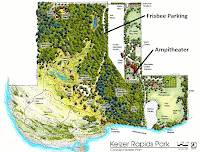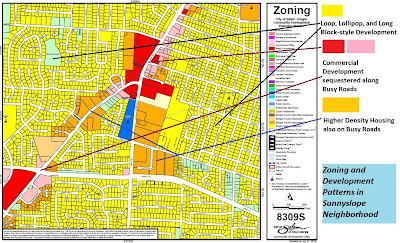 There might be no better set of buildings in Salem than these three to illustrate Jane Jacobs on building age.
There might be no better set of buildings in Salem than these three to illustrate Jane Jacobs on building age.Here the brand new, but expensive and empty, Rivers Condos; the abandoned 1911 D.A. White building; and the 1913 Boise Building, now the home of Normandy Guitars, stand side-by-side.*
 On this map of the Downtown Historic District (full size here), only the Boise Building is inside the district - located in pink at the "FR" of Front Street. The tax lots for the White Building and the Rivers Condos, at the corner of Court and Front, are all outside the district. We will touch on this later, but Jacobs would likely argue that one of the biggest problems are the voids where surface parking lots have replaced buildings.
On this map of the Downtown Historic District (full size here), only the Boise Building is inside the district - located in pink at the "FR" of Front Street. The tax lots for the White Building and the Rivers Condos, at the corner of Court and Front, are all outside the district. We will touch on this later, but Jacobs would likely argue that one of the biggest problems are the voids where surface parking lots have replaced buildings.Just as Jacobs argued for multiplicity in route selection, so she argues for multiplicity in building selection. The contrast between Keizer Station as new construction of uniform age and Salem's downtown as a jumble of new and old construction of various ages illustrates her points.
In this chapter it is natural to think of our debates about forestry. Jacobs argues for a mix of building ages like the mix of trees in old-growth forests with secondary and tertiary understory. In both the mixture and diversity yields an ecosystem with the greatest resilience and vitality. And both are on-going and sustainable.
Old Buildings Incubate Entrepreneurs and New Enterprises
Cities need old buildings so badly it is probably impossible for vigorous streets and districts to grow without them. By old buildings I mean not museum-piece old buildings, nor old buildings in an excellent and expensive state of rehabilitation...but also a good lot of plan, ordinary, low-value old buildings, including some rundown old buildings...they need old buildings to incubate new primary diversity.
Only Chains and Established Enterprises can Afford New Construction
If a city area has only new buildings, the enterprises that can exist there are automatically limited to those that can support the high costs of new construction....you will see that only operations that are well established, high-turnover, standardized, or heavily subsidized can afford, commonly, to carry the costs of new construction. Chain store, chain restaurants, and banks go into new construction. But neighborhood bars, foreign restaurants and pawn shops go into older buildings. Supermarkets and shoe stores often go into new buildings; good bookstores and antique dealers seldom do....hundreds of ordinary enterprises, necessary to the safety and public life of streets and neighborhoods, and appreciated for their convenience and personal quality, can make out successfully in old buildings, but are inexorably slain by the high overhead of new construction....Old ideas can sometimes use new buildings. New ideas must use old buildings.It should not be surprising that a manufacturer of aluminum hollow-body guitars might find an older building attractive!
Conversely, as of this June 2009 map and list of stores at Keizer Station, with the possible exception of the OSU Fan Shop, all of the stores were national chains.
From the Delta to the Sustainable Forest: Old Growth and New Understory
Even the enterprises that can support new construction in cities need old construction in their immediate vicinity. Otherwise they are part of a total attraction and total environment that is economically too limited - and therefore functionally too limited to be lively, interesting, and convenient....when mingled building age is replaced by the economic rigor mortis of one-age construction, [it leads to] inherent inefficiency and consequent needs for forms of 'protectionism.'Jacobs believes that building and development subsidies are generally overused.
"Flourishing diversity anywhere in a city means the mingling of high-yield, middling-yield, low-yield, and no-yield enterprises."
One potential problem with Salem's new proposed NCMU zoning is what Jacobs calls the problem of "the corner grocery gimmick." This entails some token ground floor retail, typically a lone corner grocery in otherwise homogeneous new construction. It is faux diversity.
Further Thoughts
In many ways this was the most provocative chapter. While many of us are fans generally of historic preservation, Jacobs' emphasis on diversity in the age of buildings means she probably would not support an excessive attachment to retaining unchanged a neighborhood whose buildings were of a uniform age. At some point rigor mortis would set in.
But her move also frees her to advocate for an essentially market-driven argument in favor of preservation - new small entrepreneurs need old buildings. Historic preservation is also an economic development strategy, which does not rely merely on tourism or aesthetics.
If such an area [with older buildings, but otherwise not lively] is examined to see which of the other three conditions for generating diversity are missing, and then those missing conditions are corrected as well as they can be, some of the old buildings must go; extra streets must be added, the concentration of people must be heightened...but a good mingling of the old buildings must remain, and in remaining they will have become something more than mere decay from the past or evidence of previous failure.The old buildings have a sort of communal sweat equity no amount of planning or subsidy can provide.
The economic value of new buildings is replaceable...but the economic value of old buildings is irreplaceable at will. It is created by time. This economic requisite for diversity is a requisite that vital city neighborhoods can only inherit, and then sustain over the years.
The strand of free-market conservatism or libertarianism is unexpected and fascinating here! Jacobs is against utopian planning and the market subsidies apparently too often necessary to prop up that planning. She shows cultural and social progressivism with a kind of libertarian conservatism. On the surface this is almost like old-school Oregon progressive Republicanism! Salem's current culture is in many ways the opposite: Social conservatism with urban renewal and market subsidies.
Maybe things like a relaxed noise ordinance; a real mix of downtown housing for a real mix of incomes ("workforce housing"); improved transit, bicycling, and walking access; and the like will encourage new entrepreneurs, encourage night life and a more diverse mixture of street users, thereby accomplishing the business development that Urban Renewal Districts have not yet reliably performed.
*Though it is not really directly relevant, in an indirect way the ownership of the two older buildings also make the point. V. Green notes in a comment that the White building "is owned by Margaret Furlong who also owns the Manning & Boise buildings on State Street." The Manning building is across the street from the Boise building, and houses Furlong's bisque porcelain ornament business. It should not surprise us that the small, essentially quasi-artisanal, manufacturing enterprises behind aluminum guitars and bisque ornaments find homes in old buildings!
Now if we can just find some enterprise for the White building! One of the problems, of course, is busy Front Street and the way it and the railroad together operate as a moat dividing downtown proper from Riverfront park. Front is designed to convey people past these buildings and past the waterfront - not designed to make connections.









































